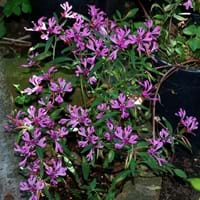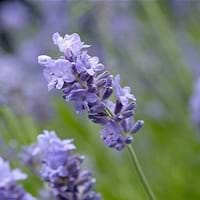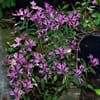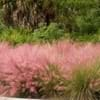Life Span
Annual
Perennial
Type
Flowering Plants
Herbs
Origin
United States, California
Western Europe, Mediterranean
Types
Santa Clara red ribbons, red ribbons, Raiche's red ribbons
Lodden Blue, Royal Velvet,Sachet,Sharon Roberts,Mitchem Gray
Habitat
Dry areas, foothill woods
Rocky Mountains, Well Drained
USDA Hardiness Zone
Not Available
5-8
Sunset Zone
A3, 1a, 1b, 2a, 2b, 3a, 3b, 4, 5, 6, 7, 8, 9, 10, 11, 12, 13, 14, 15, 16, 17, 18, 19, 20, 21, 22, 23, 24
2a, 2b, 3a, 3b, 4, 5, 6, 7, 8, 9, 10, 11, 12, 13, 14, 15, 16, 17, 18, 19, 20, 21, 22, 23, 24
Habit
Clump-Forming
Clump-Forming
Flower Color
Pink, Fuchsia, Rose, Lavender
Purple, Lavender
Flower Color Modifier
Bicolor
Bicolor
Fruit Color
Not Available
Sandy Brown
Leaf Color in Spring
Green, Gray Green
Light Green, Gray Green
Leaf Color in Summer
Green, Gray Green
Light Green, Gray Green
Leaf Color in Fall
Green, Gray Green
Light Green, Gray Green
Leaf Color in Winter
Light Green
Light Green
Plant Season
Spring, Summer
Spring, Summer, Fall, Winter
Sunlight
Partial Sun, Partial shade
Full Sun
Type of Soil
Loam, Sand
Loam, Sand
The pH of Soil
Neutral
Neutral, Alkaline
Soil Drainage
Well drained
Well drained
Bloom Time
Spring, Late Spring, Early Summer, Summer
Early Summer, Summer
Tolerances
Not Available
Drought
Where to Plant?
Container, Ground, Pot
Ground, Pot
How to Plant?
Seedlings, Stem Planting
Cuttings, Divison, Layering, Seedlings
Plant Maintenance
Medium
Medium
Watering Requirements
Allow to dry out slightly between watering
Keep the Soil well drained, Needs less watering
In Summer
Lots of watering
Lots of watering
In Spring
Moderate
Moderate
In Winter
Average Water
Average Water
Soil pH
Neutral
Neutral, Alkaline
Soil Type
Loam, Sand
Loam, Sand
Soil Drainage Capacity
Well drained
Well drained
Sun Exposure
Part sun, Partial shade
Full Sun
Pruning
Remove damaged leaves, Remove dead branches, Remove dead leaves
Remove damaged leaves, Remove dead branches, Remove dead leaves
Fertilizers
All-Purpose Liquid Fertilizer
All-Purpose Liquid Fertilizer
Pests and Diseases
Red blotch
cuckoo spot, Gray mold, Red blotch
Plant Tolerance
Drought
Drought
Flower Petal Number
Single
Single
Fragrant Bark/Stem
No
Yes
Showy Foliage
Not Available
Yes
Foliage Texture
Fine
Fine
Foliage Sheen
Matte
Matte
Attracts
Butterflies
Birds, Butterflies, Flying insects, pollinators
Allergy
Not Available
Skin irritation, Vomiting
Aesthetic Uses
Showy Purposes
Beautification, Formal Garden, Hanging Basket, Landscape Designing, Showy Purposes, Used for decorating walls, fences, gates, hedges, etc.
Beauty Benefits
Not Available
Beautiful Skin, Good Cleanser, Improve skin tone, Moisturizing, Perfumes
Environmental Uses
Air purification
Air purification, Deer resistant, Food for birds
Medicinal Uses
Not Available
Antiseptic, Appetizer, Cholagogue, Diuretic, Sedative, Stomachic, Tonic
Part of Plant Used
Not Available
Flowers
Other Uses
Used as Ornamental plant, Used for its medicinal properties
Air freshner, Beneficial species for attracting pollinators, For making oil for cosmetics, Oil is used in perfume, soaps, creams, etc., Tea-like beverage can be brewed, Used as a condiment, Used as a flavouring in food
Used As Indoor Plant
No
Sometimes
Used As Outdoor Plant
Yes
Yes
Garden Design
Bedding Plant, Showy Tree
Dried Flower / Everlasting, Container, Cutflower, Edging, Herb / Vegetable, Mixed Border, Rock Garden / Wall
Botanical Name
CLARKIA concinna
LAVANDULA angustifolia 'Munstead'
Common Name
Red Ribbons
English Lavender, Munstead Lavender
In Hindi
Clarkia concinna
Lavandula angustifolia
In German
Clarkia concinna
Echter Lavendel
In French
Clarkia concinna
Lavandula angustifolia
In Spanish
concinna clarkia
Lavandula angustifolia
In Greek
Clarkia concinna
Lavandula angustifolia
In Portuguese
Clarkia concinna
Lavandula angustifolia
In Polish
klarkia concinna
Lawenda wąskolistna
In Latin
Clarkia concinna
Lavandyla angystifolia
Phylum
Tracheophyta
Tracheophyta
Class
Magnoliopsida
Magnoliopsida
Family
Onagraceae
Lamiaceae
Clade
Angiosperms, Eudicots, Rosids
Angiosperms, Asterids, Eudicots
Tribe
Not Available
Lavanduleae
Subfamily
Not Available
Nepetoideae, Not Available
Number of Species
Not Available
Season and Care of Clarkia concinna and Munstead Lavender
Season and care of Clarkia concinna and Munstead Lavender is important to know. While considering everything about Clarkia concinna and Munstead Lavender Care, growing season is an essential factor. Clarkia concinna season is Spring and Summer and Munstead Lavender season is Spring and Summer. The type of soil for Clarkia concinna is Loam, Sand and for Munstead Lavender is Loam, Sand while the PH of soil for Clarkia concinna is Neutral and for Munstead Lavender is Neutral, Alkaline.
Clarkia concinna and Munstead Lavender Physical Information
Clarkia concinna and Munstead Lavender physical information is very important for comparison. Clarkia concinna height is 25.40 cm and width 25.40 cm whereas Munstead Lavender height is 30.50 cm and width 45.70 cm. The color specification of Clarkia concinna and Munstead Lavender are as follows:
Clarkia concinna flower color: Pink, Fuchsia, Rose and Lavender
Clarkia concinna leaf color: Green and Gray Green
Munstead Lavender flower color: Purple and Lavender
- Munstead Lavender leaf color: Light Green and Gray Green
Care of Clarkia concinna and Munstead Lavender
Care of Clarkia concinna and Munstead Lavender include pruning, fertilizers, watering etc. Clarkia concinna pruning is done Remove damaged leaves, Remove dead branches and Remove dead leaves and Munstead Lavender pruning is done Remove damaged leaves, Remove dead branches and Remove dead leaves. In summer Clarkia concinna needs Lots of watering and in winter, it needs Average Water. Whereas, in summer Munstead Lavender needs Lots of watering and in winter, it needs Average Water.





